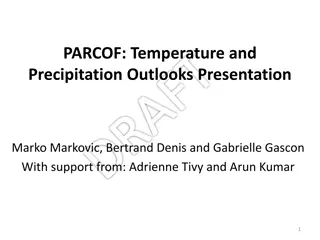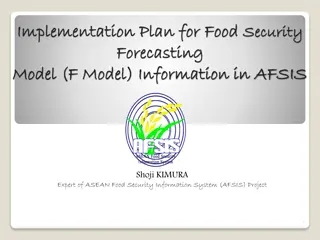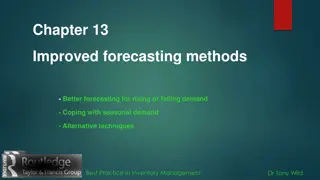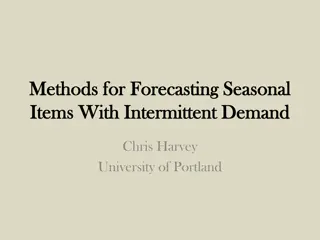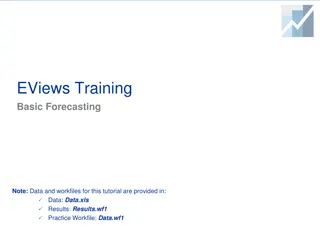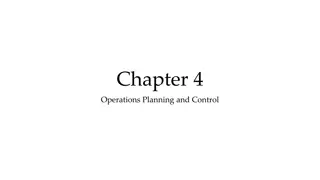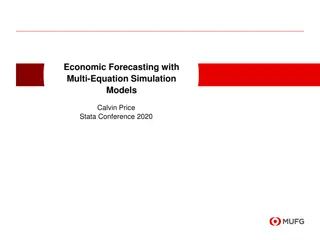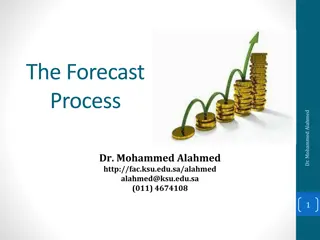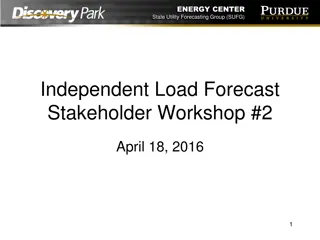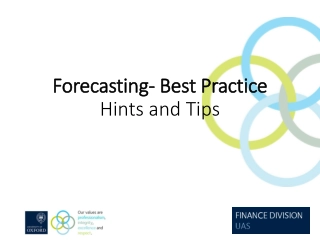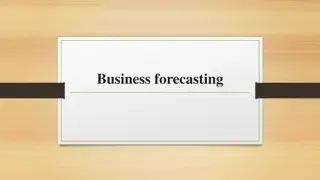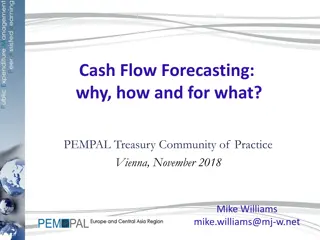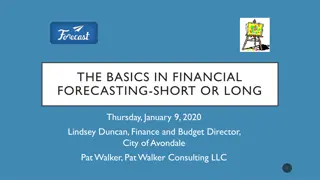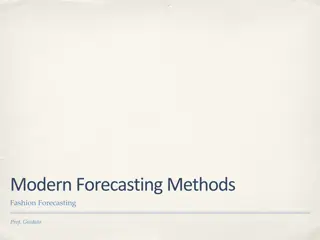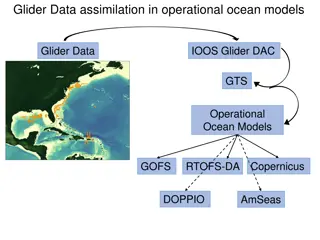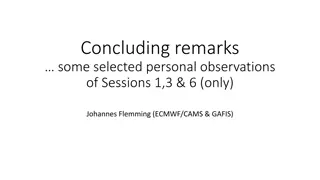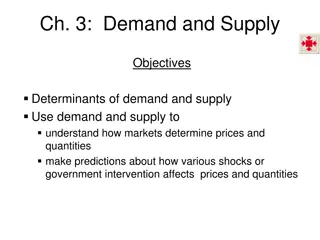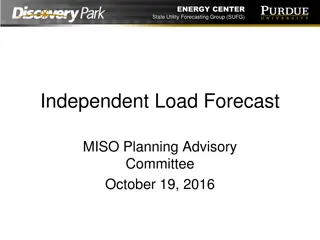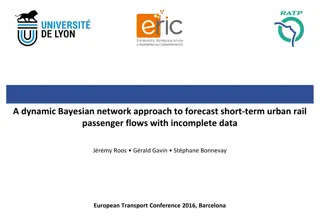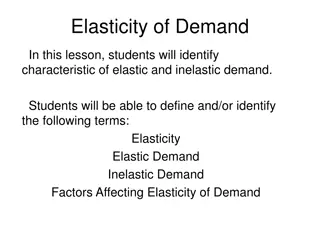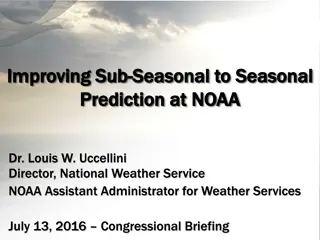Seasonal Variations in Demand Forecasting Using Multiplicative Seasonal Model
Understanding and utilizing the multiplicative seasonal model for demand forecasting involves computing average historical demand for each season, determining the average demand across all seasons, calculating seasonal indices, and estimating total demand for the upcoming year based on these factors. This method helps businesses adjust for seasonal variations in demand, leading to more accurate forecasting and planning.
- Demand Forecasting
- Seasonal Variations
- Multiplicative Seasonal Model
- Historical Demand
- Seasonal Indices
Download Presentation

Please find below an Image/Link to download the presentation.
The content on the website is provided AS IS for your information and personal use only. It may not be sold, licensed, or shared on other websites without obtaining consent from the author. Download presentation by click this link. If you encounter any issues during the download, it is possible that the publisher has removed the file from their server.
E N D
Presentation Transcript
Chapter 4 Class 3
Seasonal Variations In Data The multiplicative seasonal model can modify trend data to accommodate seasonal variations in demand 1. Find average historical demand for each season 2. Compute the average demand over all seasons 3. Compute a seasonal index for each season Estimate next year s total demand 4. 5. Divide this estimate of total demand by the number of seasons, then multiply it by the seasonal index for that season
Seasonal Index Example Demand Average 2003-2005 Average Monthly Seasonal Index Month 2003 2004 2005 Jan Feb Mar Apr May Jun Jul Aug Sept Oct Nov Dec 80 70 80 90 113 110 100 88 85 77 75 82 85 85 93 95 125 115 102 102 90 78 72 78 105 85 82 115 131 120 113 110 95 85 83 80 90 80 85 100 123 115 105 100 90 80 80 80 94 94 94 94 94 94 94 94 94 94 94 94
Seasonal Index Example Demand Average 2003-2005 Average Monthly Seasonal Index Month 2003 2004 2005 Jan Feb Mar Apr May Jun Jul Aug Sept Oct Nov Dec 80 70 80 90 113 110 100 88 85 77 75 82 85 85 93 95 125 115 102 102 90 78 72 78 105 85 82 115 131 120 113 110 95 85 83 80 90 80 85 100 123 115 105 100 90 80 80 80 94 94 94 94 94 94 94 94 94 94 94 94 0.957 Seasonal index = average 2003-2005 monthly demand average monthly demand = 90/94 = .957
Seasonal Index Example Demand Average 2003-2005 Average Monthly Seasonal Index Month 2003 2004 2005 Jan Feb Mar Apr May Jun Jul Aug Sept Oct Nov Dec 80 70 80 90 113 110 100 88 85 77 75 82 85 85 93 95 125 115 102 102 90 78 72 78 105 85 82 115 131 120 113 110 95 85 83 80 90 80 85 100 123 115 105 100 90 80 80 80 94 94 94 94 94 94 94 94 94 94 94 94 0.957 0.851 0.904 1.064 1.309 1.223 1.117 1.064 0.957 0.851 0.851 0.851
Seasonal Index Example Demand Average 2003-2005 Average Monthly Seasonal Index Month 2003 2004 2005 Jan Feb Mar Apr May Jun Jul Aug Sept Oct Nov Dec 80 70 80 90 113 110 100 88 85 77 75 82 85 85 93 95 125 115 102 102 90 78 72 78 105 85 82 115 131 120 113 110 95 85 83 80 90 80 85 100 123 115 105 100 90 80 80 80 94 94 94 94 94 94 94 94 94 94 94 94 0.957 0.851 0.904 1.064 1.309 1.223 1.117 1.064 0.957 0.851 0.851 0.851 Forecast for 2006 Expected annual demand = 1,200 1,200 12 1,200 12 Jan x .957 = 96 Feb x .851 = 85
Seasonal Index Example 2006 Forecast 2005 Demand 2004 Demand 2003 Demand 140 130 120 Demand 110 100 90 80 70 | | F | M | A | M | J | J | A | S | O | N | D J Time
Problem 4.28 Attendance at Los Angeles's newest Disney-like attraction, Vacation World, has been as follows: Guests Guests Quarter Quarter (in thousands) (in thousands) Winter 07 73 Summer 08 124 Spring 07 104 Fall 08 52 Summer 07 168 Winter 09 89 Fall 07 74 Spring 09 146 Winter 08 65 Summer 09 205 Spring 08 82 Fall 09 98 Compute seasonal indices using all of the data
Problem 4.29 Central States Electric Company estimates its demand trend line (in millions of kilowatt hours) to be: D = 77 + 0.43Q where Q refers to the sequential quarter number and Q = 1 for winter 1986. In addition, the multiplicative seasonal factors are as follows: Quarter Factor (Index) Winter 0.8 Spring 1.1 Summer 1.4 Fall 0.7 Forecast energy use for the four quarters of 2011, beginning with winter.
Problem 4.29 2011 is 25 years beyond 1986. Therefore, the 2011 quarter numbers are 101 through 104
Associative Forecasting Used when changes in one or more independent variables can be used to predict the changes in the dependent variable Most common technique is linear regression analysis We apply this technique just as we did in the time series example
Associative Forecasting Forecasting an outcome based on predictor variables using the least squares technique xy - nxy x2 - nx2 ^ y = a + bx b = ^ where y = computed value of the variable to be predicted (dependent variable) a = y-axis intercept b = slope of the regression line x = the independent variable though to predict the value of the dependent variable a = y - bx
Associative Forecasting Example Sales Local Payroll ($000,000,000), x 1 3 4 2 1 7 ($000,000), y 2.0 3.0 2.5 2.0 2.0 3.5 4.0 3.0 Sales 2.0 1.0 | 1 | 2 | 3 | 4 | 5 | 6 | 7 0 Area payroll
Associative Forecasting Example x2 Sales, y Payroll, x xy 2.0 3.0 2.5 2.0 2.0 3.5 1 3 4 2 1 7 1 9 2.0 9.0 10.0 4.0 2.0 24.5 y = 15.0 16 4 1 49 x2 = 80 x = 18 xy = 51.5 51.5 - (6)(3)(2.5) xy - nxy b = = x2 - nx2 = .25 80 - (6)(32) x = x/6 = 18/6 = 3 a = y - bx = 2.5 - (.25)(3) = 1.75 y = y/6 = 15/6 = 2.5
Associative Forecasting Example ^ y = 1.75 + .25x Sales = 1.75 + .25(payroll) If payroll next year is estimated to be $600 million, then: 4.0 3.25 3.0 Sales 2.0 Sales = 1.75 + .25(6) Sales = $325,000 1.0 | 1 | 2 | 3 | 4 | 5 | 6 | 7 0 Area payroll
Standard Error of the Estimate A forecast is just a point estimate of a future value This point is actually the mean of a probability distribution 4.0 3.25 3.0 Sales 2.0 1.0 | 1 | 2 | 3 | 4 | 5 | 6 | 7 0 Area payroll Figure 4.9
Standard Error of the Estimate (y - yc)2 n - 2 Sy,x = where y = y-value of each data point yc = computed value of the dependent variable, from the regression equation n = number of data points
Standard Error of the Estimate Computationally, this equation is considerably easier to use y2 - a y - b xy Sy,x = n - 2 We use the standard error to set up prediction intervals around the point estimate
Standard Error of the Estimate 39.5 - 1.75(15) - .25(51.5) 6 - 2 y2 - a y - b xy Sy,x = = n - 2 Sy,x = .306 4.0 3.25 3.0 Sales The standard error of the estimate is $30,600 in sales 2.0 1.0 | 1 | 2 | 3 | 4 | 5 | 6 | 7 0 Area payroll
Problem 4.24 Howard Weiss, owner of a musical instrument distributorship, thinks that demand for bass drums may be related to the number of television appearances by the popular group Stone Temple Pilots during previous month. Weiss has collected the data shown in the following table: Demand for Bass Drums 3 6 7 5 10 7 number of TV appearances 3 4 7 6 8 5 A. Graph these data to see whether a linear equations might describe the relationship between the group's television shows and bass drum sales. B. use the least squares regression method to derive a forecasting equation. C. What is your estimate for bass drum sales if the Stone Temple Pilots Performed on TV nine times last month?
Problem 4.24 (a) Graph of demand The observations obviously do not form a straight line but do tend to cluster about a straight line over the range shown.
Problem 4.24 (b) Least-squares regression:
Problem 4.24 The following figure shows both the data and the resulting equation: ?
Problem 4.24 (c) If there are nine performances by Stone Temple Pilots, the estimated sales are: Y =.676+1.03x Y9=.676+1.03 9=.676+9.27=9.93 drums 10 drums




